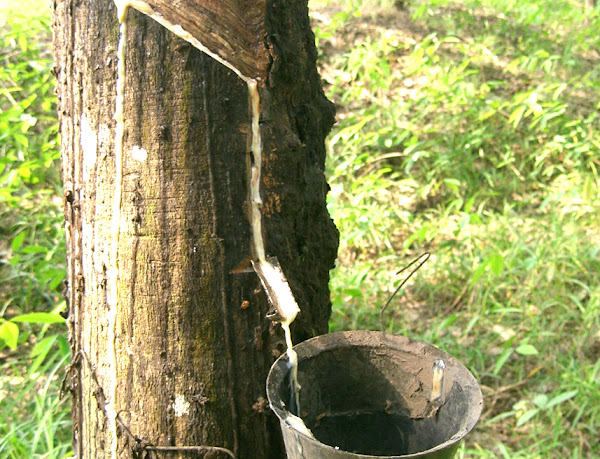Commercial or large scale rubber farming is a very old and popular business in many countries around the world. People are using rubber from the ancient time and it’s production is profitable. Rubber is actually an elastic solid material which is retrieved from latex of many tropical trees. It is used for many purposes which may include erasers to tires, tubes and industrial products.
Rubber is also known by many different names, such as natural rubber, India rubber, latex, caucho, caoutchouc, Amazonian rubber etc. Thailand, Malaysia, Indonesia and India are the leading rubber producers. ‘Hevea brasiliensis’ is the most important and commercially cultivated rubber plant. These plants basically grows up to 30 meter height and begins yielding latex at 6 to 7 years age.
More than 28 million tons of rubber were produced in the year of 2017. And among the production, 47% was natural. The price of natural rubber is determined, to large extent, by the prevailing global price of crude oil (since the bulk is synthetic, which is derived from petroleum).
Asia was the main source of natural rubber, accounting for about 94 percent of output in the year of 2005. And top 3 largest rubber producers are Thailand, Indonesia and Malaysia (together account for around 72 percent of all natural rubber production).[1]
Natural rubber is not cultivated widely in it’s native continent of South America because of the South American leaf blight, and other natural predators available there.
Uses of Rubber
Rubber is used for many different purposes. Uncured rubber is used for cements, insulating, for adhesive and friction tapes. And for crepe, rubber is used in insulating blankets and footwear.
While the vulcanized rubber has many more applications. Resistance toabrasion makes softer kinds of rubber valuable for the trends of rubber valuable for the treads of vehicle tires and conveyor belts.
Around 25 million tonnes of rubber are produced each year globally, of which only 30 percent is natural. The remainder is synthetic rubber derived from petrochemical sources.
The top end of latex production results in latex products such as surgeon’s gloves, balloons and relatively high-value products.
Advantages of Rubber Farming Business
Like many other agri business, commercial rubber farming also has numerous advantages or benefits. Here we are trying to describe the top benefits of commercial rubber farming business.
- Commercial rubber farming is relatively a simple and easy business.
- Beginners can also start this business easily. It is just like starting other crop farming business.
- Commercial production of rubber is very easy, and profitable at the same time. So, it can be a great business for making money.
- Beginners can start this business with proper training and support.
- Commercial rubber farming is very profitable and it can be a great employment source for the people (especially for the educated but unemployed people).
- Both demand and value of rubber and all related products are high.
- Many people are already doing rubber farming business commercially for making profits.
- You don’t have to worry much about starting this business if you are a beginner. Because many people are already doing this business.
- Marketing rubber products is relatively easy. Because rubber and all the related products have very good demand and value in the market.
- Production costs are relatively high, but the profits are also high and you will get back your invested money soon.

How to Start Rubber Farming?
Starting commercial rubber farming business is relatively easy if you follow every steps carefully. You can start this business easily with little practical knowledge. We recommend starting commercial rubber production after having full training. Here we are trying to describe more information about commercial rubber farming business from planting, caring to harvesting and marketing.
Site Selection
Rubber plants grow well in highly deep weathered soils which consist of laterite and lateritic soils. But the plants grow best in well drained porous soils with moderate acidic in nature. If there is a good organic matter in the soil, then the rubber plants also thrives in red alluvial soils. pH between 5.0 and 6.0 is best for rubber cultivation.
Prepare the Soil
Remove weeds and make the land clear before planting. Then make pits with dimensions of 120 cm x 45 cm x 60 cm. You will be able to make 200 to 250 pits per hectare land. Add 10 kg organic matter and 150 grams of rock phosphate per pit.
Climate Requirement For Rubber Farming
Commercial rubber production requires heavy and well distributed rainfall of 200 cm to 300 cm, having humidity about 75 percent. Ideal temperate for proper growth of rubber plants is between 20°C and 35°C. The plants require 5-6 hours of sunlight. Freezing temperatures will halt the growth of rubber plants and strong winds are not suitable for commercial rubber farming.
Propagation
Propagation in rubber farming is generally done through green budding, crown budding and brown budding.
Purchase Plants
Rubber plants are easily available in the nurseries. You can collect plants for planting from any of your nearest nurseries.
Planting
Plant the small plants in the main field where you have made the pits ready earlier. June to July is the best season for rubber plantation.
Caring
Taking good care of the rubber plants will ensure good production. Here we are describing more about the caring process.
Fertilizing: Rubber plants respond very well to organic matter and fertilizers. Apply 10-12 kg of well rotten organic manure and 225 grams of rock phosphate in each pit during land preparation. And this dosage is recommended up to 4th year of planting.
Irrigation: Watering or irrigation should be provided depending upon plant growth.
Controlling Weeds: Weeds consume nutrients from the soil and the rubber plants will suffer. Weeding is generally carried out manually or chemically or through a combination of both.
Intercropping: Intercropping will generate some extra revenue during the first two years of cultivation. Some suitable intercrops in rubber farming are turmeric, ginger, vegetables, tuber crops, banana, pineapple, medicinal or herbal plants etc.
Cover Cropping: Cover cropping is very helpful in sloppy areas for preventing soil erosion. This also helps to enhance the soil fertility and controls the weed growth along with soil temperature. Intercropping leguminous crops will help in nitrogen fixation in the soil. Calopagonium muconoides, centrosema pubescens, pueraria phaseoloides and desmodium evalifolium are common cover crops in rubber farming.
Pests & Diseases
Mealy but, cockchafer grub, scale insect, white ant and mites are the main pests in rubber cultivation. Abnormal leaf fall, bird’s eye spot, secondary leaf fall, powdery mildew, leaf spot, bark cankers, dry rot, pink disease, stump rot, collar rot and brown rot diseases are the main diseases found in rubber farming. Contact your local agriculture extension office or horticulture department for more information about controlling these pests and diseases.
Yield
Exact amount of yield depends on the method of propagation. But yield usually increases year by year in any method. Total yield reaches peak after 14 to 15 years of planting. An annual average yield of rubber is about 375 to 400 kg per hectare from seedlings trees. But the average yield is 800-1000 kg per hectare in budded plants.
Marketing
Marketing rubber products is relatively easy. Although, you should determine your marketing strategies before starting this business.
These are the common steps and ways for starting and operating a successful rubber farming business. Hope this guide has helped you! Good luck and may God bless you!






